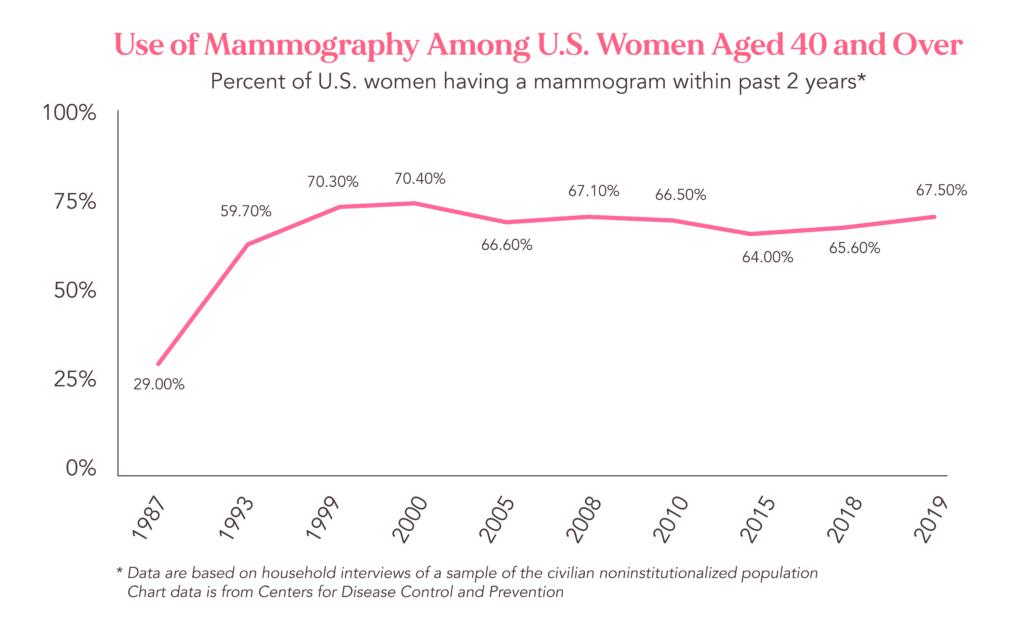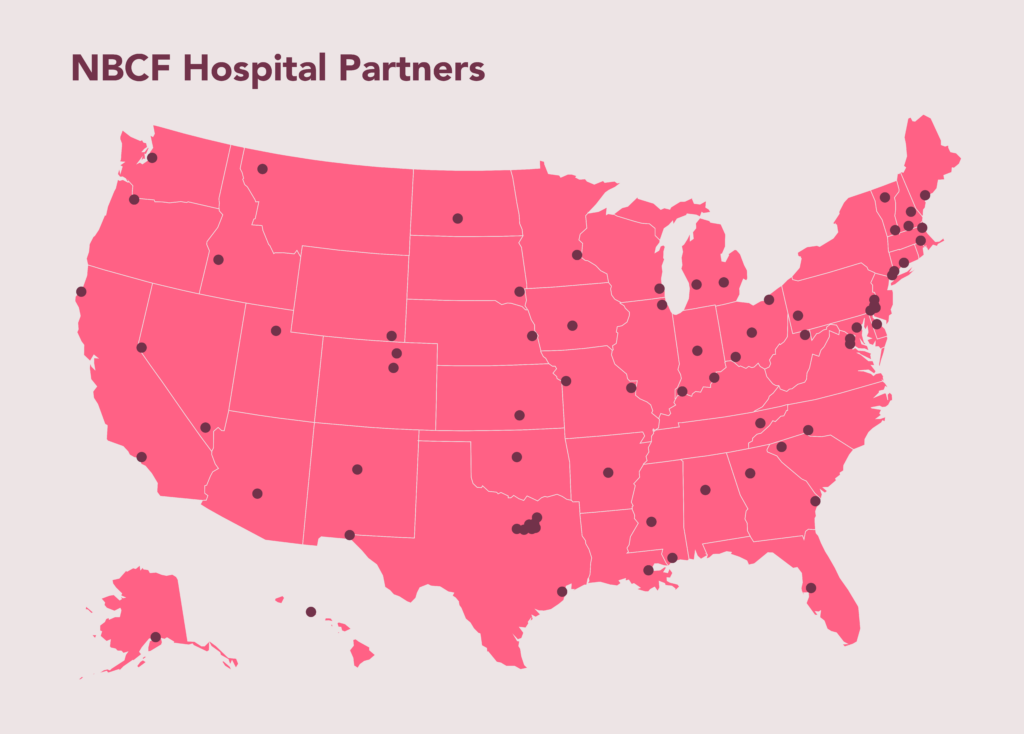National Mammography Day
National Mammography Day is observed annually on the third Friday of every October, during Breast Cancer Awareness Month. This year, it will be celebrated on October 17, 2025.
National Mammography Day is important because it serves as a reminder and encouragement to women to get screened for breast cancer through receiving a mammogram.
When detected early, in the localized stage, the 5-year relative survival rate for breast cancer is 99%, and mammograms are key to the early detection of breast cancer.
National Mammography Day History
In 1994, President Bill Clinton proclaimed the third Friday in October as National Mammography Day, stating,
“The threat of breast cancer touches everyone. All women are at risk for breast cancer, including those with no family history of the disease. … Together, we must work to make sure that every woman is informed about breast cancer and about the importance of regular examinations, including high-quality screening mammography. And we must ensure that all women have access to this invaluable preventative care.”1
National Mammography Day has been celebrated each year since President Clinton’s proclamation, serving as a reminder to everyone about the importance of screenings and early detection.
Mammography Milestones & Metrics
The history of mammography
- 1913: The first mammogram—a rudimentary x-ray of the breast to determine the presence of breast cancer—was performed by German surgeon Albert Solomon.2
- 1965: The first imaging unit dedicated to mammography was invented by French physicist Charles Gross. These first mammogram images were similar to chest x-rays and not very detailed or clear.3
- 1960s and beyond: Mammography technology advancements continued through the decades, producing clearer and more contrasting images of breast tissue, making it easier to identify abnormalities. These advances also helped deliver lower doses of radiation to women during their screenings.4
- Today: Modern mammography utilizes digital imaging, allowing mammogram images to be read on a computer rather than x-ray film, reducing wait time and increasing the quality of the images.4 Today’s use of 3D mammograms, or tomosynthesis, detects 41% more invasive breast cancers than traditional 2D mammograms.5
Mammography facts and statistics
- On average, about 40 million screening mammograms are conducted in the U.S. each year.6
- In 2019 (most recent year data is available), only 67.5% of women ages 40 and over had received a mammogram within the last two years.7
- Mammography has helped reduce breast cancer mortality in the U.S. by nearly 40% since 1990.8
- Mammography screening cuts the risk of dying from breast cancer nearly in half.6

How to Observe National Mammography Day
If you’re a woman or a loved one…
Schedule your mammogram
A great way to observe National Mammography Day is to prioritize your own breast health by scheduling your annual mammogram! And then encourage the women in your life to schedule theirs as well.
All women ages 40 and over should receive an annual screening mammogram. Search for NBCF-funded mammogram facilities here.
Take the Mammo Pledge
Show others that you prioritize your health through annual mammograms and health screenings. Take the NBCF Mammo Pledge to join the count, show your support, and commit to yearly screenings!
Learn how to perform a breast self-exam
All adult women, not just those over 40, should perform a monthly breast self-exam to stay breast self-aware, learn how their breasts normally look and feel, and keep track of any breast changes or abnormalities to share with your healthcare provider. Learn how to perform a breast self-exam and start doing an exam at the same time each month.
Help raise awareness online
Spread the word about the importance of early detection by posting about National Mammography Day on your social media accounts. You can easily download and share breast cancer statistics graphics from our NBCF Graphics Library!
Pay it forward
It can be hard to think about, but some women have to choose between buying groceries for their families and receiving routine preventative care screenings, such as mammograms. But you can help! On National Mammography Day, you can donate to help women in need receive the care—and screenings—they deserve.
Provide a message of encouragement and support
Breast cancer patients and survivors need all the care and support we can provide. In honor of National Mammography Day, leave a message of encouragement for them on the NBCF Wall of Support.
Wear pink
While wearing pink won’t help prevent or diagnose breast cancer, it can be a good conversation starter to talk to others about the importance of early detection through receiving annual mammograms.
If you’re a brand or company…
There are many ways for companies—big and small—to get involved and support the breast cancer community! From raising awareness and funds for NBCF and the women we serve, to offering NBCF’s Breast Cancer Awareness in the Workplace workshop to your employees, we’re here to help! Reach out to [email protected] for more information about how your company can become an official NBCF partner.
NBCF’s National Mammography Program
One way NBCF supports its mission of Helping Women Now is through growing and managing a network of partner medical facilities across the United States. These NBCF-funded partner facilities in turn provide free or low-cost breast screenings and diagnostic services to women in need through the National Mammography Program.
Search for a mammogram facility near you
If you or someone you know is in need of a free or low-cost mammogram, you can search our database of NBCF partner facilities by clicking Find a Facility.

If there is not an NBCF-funded facility in your area, you can also search the FDA Mammogram Facilities database using your zip code to find a facility near you.
Mammogram Toolkit: Essentials for a Stress-Free Screening Experience
Below are several resources and free educational guides that will help your next mammogram experience be as simple and stress-free as possible.
- What are Mammograms? This webpage explains what mammograms actually are, why they are important, recommendations for when to get a mammogram, and what to do if you receive an abnormal mammogram result.
- How to Schedule a Mammogram. The mammogram scheduling process can sometimes be confusing or stressful. We’re here to help! Our How to Schedule a Mammogram blog post tells you what to say, what to expect, and how to navigate the scheduling process.
- How to Prepare for a Mammogram. This blog post will help you prepare for your upcoming mammogram with tips for how to make your mammogram easier and more comfortable, as well as dos and don’ts for the day of your appointment. It also includes a handy checklist so you’re sure to be prepared.
- 4 Things to Share at Your Next Mammogram. We know that mammograms can cause some anxiety and even slight discomfort at times. But this blog post will set you at ease and equip you to advocate for your best, most comfortable mammogram experience.
- Have a No F.E.A.R. Plan. Read about the personal experience of NBCF Founder and CEO Janelle Hail as she outlines a No F.E.A.R. Plan for National Mammography Day and every day.
Mammogram 101 Guide
Mammograms can be stressful and even a bit scary. But you can prepare yourself with critical information before you get a mammogram. This free resource answers what you should do before, during, and after your mammogram screening.
Get the Free GuideAnswers to Your Mammogram Questions
When do I need to start getting mammograms?
All women ages 40 and over who are at average risk for breast cancer should receive an annual mammogram. If you have a family history of breast cancer or other risk factors, you may need to begin receiving mammograms earlier than 40. Additionally, all adult females should perform a monthly breast self-exam. Talk with your healthcare provider about your specific timeline for mammograms and other health screenings.
How often do I need to get mammograms?
National Breast Cancer Foundation (NBCF) and American Cancer Society recommend that all women ages 40 and over at average risk for breast cancer should receive screening mammograms regularly at an interval of once a year. However, talk with your healthcare provider about your appropriate mammogram schedule and timeline.
Are mammograms free or covered by insurance?
Most screening mammograms are fully covered as preventative health services under most health insurance plans. If you are uninsured or cannot otherwise afford a mammogram, NBCF’s National Mammography Program can help.

